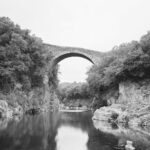Ebbe Stub Wittrup Devil’s Bridges
DEVIL’S BRIDGE
– On Ebbe Stub Wittrup’s Devil’s Bridges
It is said that the devil has many forms. He has several bridges as well. In Europe there are many so called devil’s bridges, especially in the south. They are from medieval times and were constructed in areas with mountains. Almost physically impossible these round arc-constructions are floating across rivers, abysses and gorges, in places where it would not seem possible to build anything at all. This could be the reason why the devil’s name arouse. Nobody knows for certain. The bridges are associated with myths remarkably identical in spite of their different geography. According to legend it was necessary to make a deal with the devil in order to be able to complete the challenging building projects. In return he would receive the first soul to cross the bridge, and therefore attempts were made to fool him by making pigs and goats and other non-human creatures cross the bridge. With more or less success.
Ebbe Stub Wittrup’s series Devil’s Bridges sets out from the enigma surrounding the bridges. All though they are physical constructions with a function, they have mythological status as well. The bridges are representations of a story impossible to decode. In this sense Devil’s Bridges reminds of other projects by the artist Presumed Reality for instance, that also oscilliates between something reel and unreal, not offering the beholder any chance to determine the story behind the motifs, who the persons in the images are, and what they are actually doing. Just like the mountainscapes of this series, the mythological buildings of Devil’s Bridges have sublime qualities and are striking motifs. And it is not the first time in art history the devil’s bridges have been made the object of artistic interpretation. For instance J. M. W. Turner painted the devil’s bridge at St. Gotthard Pass in Switzerland, also among Ebbe Stub Wittrup’s motifs.
The photographs are in black and white and made with a technical large format camera in order to show the perspective most accurately. The inspiration comes from Bernd and Hilla Becher’s conceptual photos of industrial buildings in Germany and other places, that have achieved iconic status. Ebbe Stub Wittrup uses the same type of camera and seeks a similar neutral expression. The representation of the light is accurate so the motif will not seem “photographed”, but as it looked at the point in time when it was photographed. The shootings took place either by sunrise or sunset where everything lies in the shadow. Technically, the light was measured after the shadow, which means that the sky is light whereas the bridge becomes very clear.
In every image the round arc of the devil’s bridge is reflected by river water and a circle reminding of a passage or a hole is being created. However, this opening is illusory, almost an illustration of the thematic of the series. The bridges only reflect themselves, which underlines their enigma. There is a story behind them that will never be fully known and yet this is also what makes them open to interpretation.
A common strategy in conceptual art is to highlight overlooked and unvalued everyday objects. In Ebbe Stub Wittrup’s Devil’s Bridges the approach is quite the opposite. The bridges have picturesque qualities and the motifs are clearly beautiful, but in the end this does not seem to be of much importance to the artist, which is also expressed in the sober way the bridges were photographed. Essential is the story behind and how the devil’s bridges work as representations of something impossible to decode. Mythological constructions in places, where rationality ends and myths begin.





